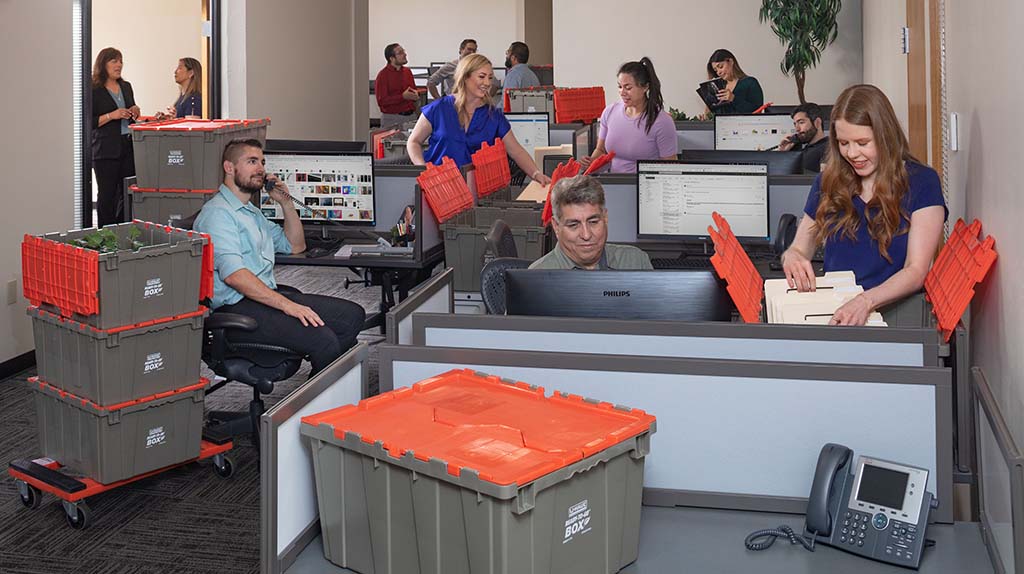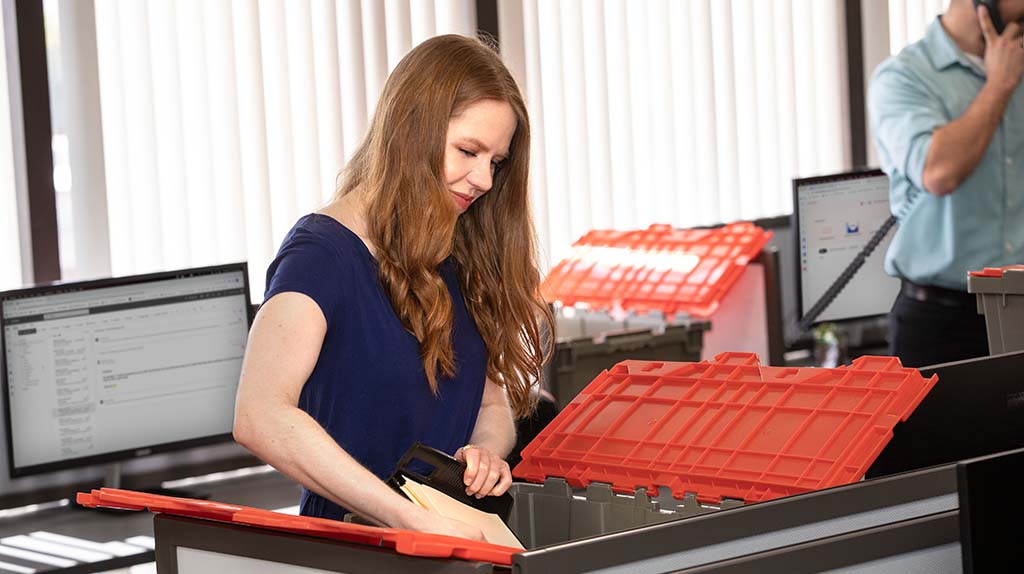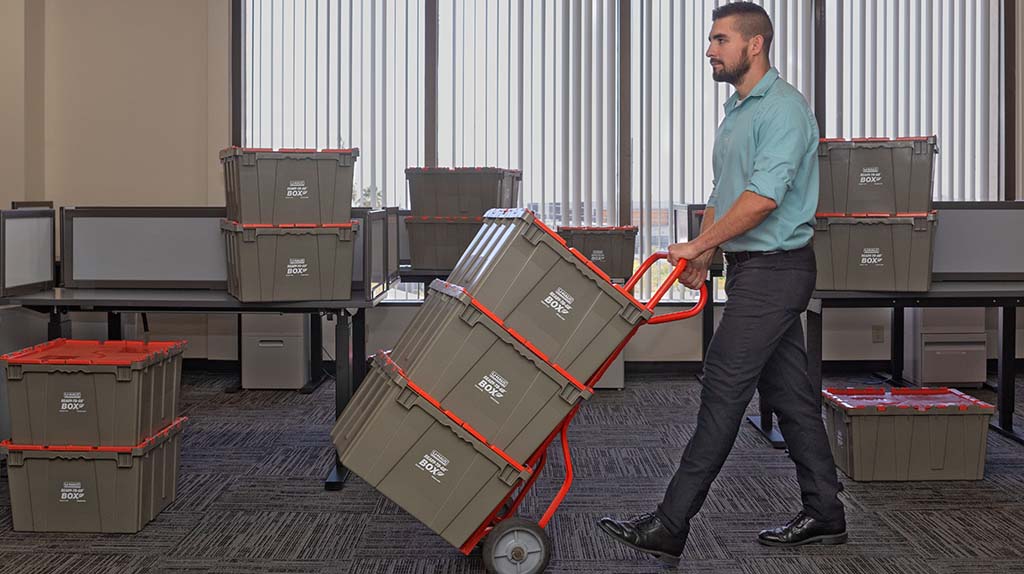An office move isn’t a simple task, but it doesn’t have to be an overcomplicated process either. We’ve compiled an essential checklist along with a timeline on when you should complete each task.
DOWNLOAD OFFICE MOVE CHECKLIST
Moving Help® has office moving labor providers who are ready to assist in any way with your office move. Whether you need packing and unpacking help, loading or unloading help, cleaning help, or more, they’re here to help make your moving day easier.
6-18 Months Before Moving Day
1. Plan office relocation
You’ll want to give yourself enough time to tour potential new places, make sure you can pack everything to move on time, and consider moving close to when your current lease ends.
2. Create a planning committee
A move will take some serious effort and time to do it right. Select a planning committee who will oversee that tasks get done and on time. Within that planning committee, you should select someone who is ultimately in charge.
3. Check office employee head count
If your company has outgrown its space, you’ll need to figure out how many employees will work at your new office. If your company is embracing a work-from-home or hybrid approach, you might be able to downsize your office space.
4. Create a moving budget
To avoid overspending, create an office moving budget to track expenses and determine the affordability of Service Providers, supplies, and other costs. Bonus tip, allocate a portion of the budget for unexpected costs to provide a safety net or potential funds for a celebration party.
5. Create a budget for your new office
Create a budget for your new office to ensure affordability. You should consider rent, fees, security deposit, insurance, utilities, and more.
6. Research Service Providers
Take your time to find affordable, local moving labor. The Moving Help Marketplace offers more than 7,100 Service Providers across all 50 U.S. states and 10 Canadian provinces with a track record of more than 5 million completed moves and more than 2.5 million customer reviews.
Some local Moving Helpers have hundreds to thousands of reviews from customers sharing their personal experience with the helper you’re considering.
7. Determine moving insurance
You need to decide whether getting moving insurance for your office move is worth it. Moving Help offers Safeload® coverage, and you can pay $22 for $5,000 worth of protection.
8. Communicate internally
Make sure you communicate with all employees and staff members about the upcoming move.
9. Gather employee feedback and preferences
Your employees may like to have some say regarding their preferences for their new office, parking, safety when leaving at night, commuting, and more. You can meet with them one-on-one or have a companywide meeting. If neither is possible, conduct a survey.
10. Communicate externally
You can inform customers about your business’ move to a new location by using signs, social media, and updating your Google Business Profile. Additionally, you need to inform clients, partners, service providers, suppliers, internet provider, insurance company, telephone company, bank and financial institutions, food or water bottle services, and other relevant stakeholders.

11. Assign responsibilities among departments or team leaders
Once the planning committee figures out what needs to be done, have them delegate tasks within each department. You can assign responsibilities among department leaders or select team leaders.
12. Create an inventory list
Create an inventory list to keep track of all your belongings in case you lose or misplace something. It’ll help you audit everything during transportation from your old location to your new location.
13. Give enough notice to your landlord
When you move, give enough notice to your landlord. Your lease will determine how much notice you need to give. Accidentally breaking your lease early or not giving enough notice could mean losing your security deposit.
3-6 Months Before Moving Day
1. Choose a moving date
After you’ve decided to hire a labor-only moving labor based on your research, make sure you select the time of day and moving date you want to move. Finish the checkout process and book a Moving Help order. Your helpers will contact you within 24-48 hours to discuss your office move and address any questions or concerns.
2. Triple check you’re not breaking any lease agreement
It never hurts to triple or quadruple check you’re not breaking any parts of your lease agreement. The last thing you’ll want is a broken lease agreement.
3. Collect moving boxes
Purchase the required number of moving boxes from U-Haul. If you have any unused boxes, return them for a refund.
Want to find free moving boxes? Explore the U-Haul program Take a Box, Leave a Box.
4. Collect packing supplies
Purchase all the packing supplies you need and grab packing paper, bubble wrap, packing peanuts, and extra paper packing tape. U-Haul has everything you might need for your office move.

5. Measure larger items to make sure they fit
Measure larger items like refrigerators, conference tables, and couches to decide whether their dimensions work in the new space. If they won’t fit, consider donating, selling, or throwing them away. You don’t want to wait until moving day to find out they won’t fit in your new office.
6. Figure out your office equipment and furniture needs
Conduct an audit to determine the office equipment and furniture that’s required for your new office space. Assess what you can bring with you and what you may need to acquire.
7. Donate, sell, or dispose of excess equipment and furniture
If you won’t be taking certain equipment or furniture to your new office, decide whether to sell, donate, or responsibly dispose of these items.
8. Order new office equipment and furniture in advance
Ensure timely delivery of new office equipment and furniture by placing orders well ahead of the moving day. Avoid last-minute orders that may result in delays. Your employees will appreciate the fresh look of their new workspace.
2-3 Months Before Moving Day
1. Map out new office space
Map out where everything will go before moving day. It’ll help make a faster move if everyone knows where everything goes. Consider labeling rooms or spaces by color code to create a faster process.
2. Start, end, or transfer utilities
Transfer utilities such as electricity, water, and gas from your old office to your new office. If you can’t transfer your utilities, make sure you start and end your utilities at the appropriate time.
3. Consider utilizing a storage unit
If you need extra space for whatever reason, consider renting a storage unit. In fact, you can hire Moving Help storage unit moving labor providers to help you load or unload your items when you’re ready.
4. Collaborate with legal team to update contracts
Work with your legal team to update contracts that need to be updated with your new address.
5. Consider business insurance policy
If you can’t transfer your current business insurance policy, take the time to find a new insurance business policy.
6. Coordinate with Information Technology
IT is an extremely important part of any business in 2023. Schedule a meeting with them to discuss IT systems, equipment, moving logistics, and needs for the upcoming move.
7. Talk to your employees again
As you get closer to moving day, reach out to your employees again. Your moving day plans might’ve changed, and it’s important to keep everyone on the same page to avoid confusion later.

1-2 Months Before Moving Day
1. Start packing your non-essential items
Pack your non-essential items first, which could include seasonal decorations, party supplies, and extra stacks of printer paper.
2. Order new keys and badges
Verify you ordered all keys or badges needed prior to moving day, so employees can access the new building.
3. Start packing your essential belongings
Pack more and more essential belongings as you get closer to your moving day. Essential items could include printers, second computer monitors, and dry-erase whiteboards.
4. Backup files
Make sure all files are backed up on a hard drive or the cloud. In case an electronic device receives damage during transportation, all the data for it is saved securely elsewhere.
5. Share a building? Make sure to request reservations
Do you or will you share a building with other tenants? If so, you’ll want to reserve the elevator or loading dock on moving day. If not, you can skip this step.
6. Have employees pack personal belongings
It’s easier to have employees pack up their personal belongings themselves. Give employees enough time to pack by ending one workday early because everyone will be different in how long they take to pack personal items.

2 Weeks to 1 Month Before Moving Day
1. Notify post office and bank
Notify the United States Postal Service and your financial institution about your address change if you haven’t already.
2. Reconfirm moving time and date with Service Providers
Reconfirm the moving time and date with your Service Provider by contacting them via text or call. Discuss any new information or last-minute changes regarding the move.
3. Walk through the new place before moving in
Walk through your new place to make sure everything is in working order. Check the lights and water and ensure there are no exposed wires. If you notice any issues, contact your new landlord to have them fix it before moving day.
Day Before Moving Day
1. Return all keys, badges, and codes
Guarantee all keys, badges, and codes are returned to you, so you can hand them to your landlord. Conduct an audit with everyone’s access and check off each item as you receive them from each employee.
2. Finish packing
Complete the packing of any remaining items to avoid your helpers from waiting on you during moving day.
Moving Day
Finally, it’s moving day. If you followed our checklist and stuck to your timeline, you’re already off to a great start. Take a moment to acknowledge your progress so far.
To have a handy copy of our checklist that you’ve been following, feel free to download the PDF version below.
DOWNLOAD OFFICE MOVE CHECKLIST
1. Meet Service Providers at both locations
Meet your Moving Helpers at your old office or new office or have someone at both locations. The providers will need access to the building, go over their moving plan, and discuss the best walking path. Be there to supervise the work and answer any questions.
2. Bring moving day refreshments and food
Depending on how long your move will take, consider purchasing food and beverages for your moving labor and team members who are helping. Be aware of allergies and dietary restrictions before buying anything.

3. Walk through your old place before leaving
Make sure you don’t leave anything behind by doing a once-over to confirm you’ve removed all trash, signs, branding elements, sensitive information, or anything else that belongs to you.
4. Pay and tip Service Providers
Get cash ahead of time if you plan on tipping. If your local providers were excellent and successfully completed your move to your satisfaction, give them your Payment Code. Several factors will determine how much to tip your local moving labor. Forget to tip in person? You can tip Moving Help Service Providers when leaving a review online.
After Moving Day
1. Arrange phone installation
Have your IT department handle phone installation or schedule with your phone service provider to install your business phones.
2. Test technology
Test your technology such as the internet and telephone lines to ensure everything is running smoothly. If it isn’t working, work with your IT department or your service provider to solve the problem.
3. Clean your old place and take pictures of any damages
Clean your old place yourself or hire professional moving labor from Moving Help to clean it for you. Take time to patch or fix any damage. Afterward, take pictures or videos of everything to document any damage that occurred during your lease and what preexisting damages were there already.
4. Unpack everything
Moving day is over so take the time to unpack everything. The kitchen will need to be stocked, and the cabinets will need to store printer ink.
5. Have a walkout inspection with your landlord
Schedule a time to have a walkout inspection with your landlord. You can inspect the place together and go over any damage. This way, you can dispute anything and not be surprised about losing part of your security deposit over it.
6. Celebrate!
Congratulations. You’ve successfully completed your move. As you begin unpacking everything, consider planning a celebration party for everyone’s hard work involving the move.
Bonus Moving Tips
- Don’t wait until the last minute to get everything done
- Don’t exclude staff or employees from the moving process
- Move non-essential items on your own prior to moving day to save time and money
- Make sure to involve staff and employees with the moving process
- Create a realistic timeline and stick with it
Plan Your Office Move Today
By following our comprehensive checklist, you can use it to guide you through the relocation process. By implementing these steps, you’ll create a smoother move for your employees and office. Moving Help offers labor-only office local moving labor providers who are ready to support you to meet your needs.
DOWNLOAD OFFICE MOVE CHECKLIST
With careful planning, coordination, and organization, you can create a seamless transition in a new and improved workspace today.
Frequently Asked Questions for Office Moving
Q: What is involved in an office move?
A: Many tasks are involved in an office move. The top 10 tasks to keep in mind are: Planning and organization, finding a new office space, lease and legal considerations, furniture and equipment, IT and technology, communication and address change, packing and logistics, utilities and services, employee involvement and communication, and post-move settling.
Q: How long does it take to relocate an office?
A: A local or short-distance office relocation move could take anywhere from a few hours to the whole day. For a long-distance office move, it’ll depend on how many days it’ll take to move everything to its new location, which could mean a couple of days to a couple of weeks.

Q: How can I successfully move my office?
A: To successfully move your office, you can follow these 13 tips: Plan early, form a relocation team, assess and purge, budget and logistics, notify stakeholders, coordinate IT and technology, update addresses and licenses, coordinate utilities and services, communicate with Service Providers, pack and label, communicate employee responsibilities, set up the new office, and post-move support. By downloading our checklist for office moves, you can set yourself up for success.
Q: What are the steps to move my office?
A: The steps to move your office can vary depending on your specific needs and circumstances. A general outline of 14 steps when planning an office move includes: Establish a moving committee, set a timeline, develop a budget, assess the new office space, notify stakeholders, coordinate IT and technology, organize packing and labeling, coordinate with local providers, update utilities and services, plan for furniture and equipment, pack and move, unpack and set up, update address and communication, and post-move evaluation.



